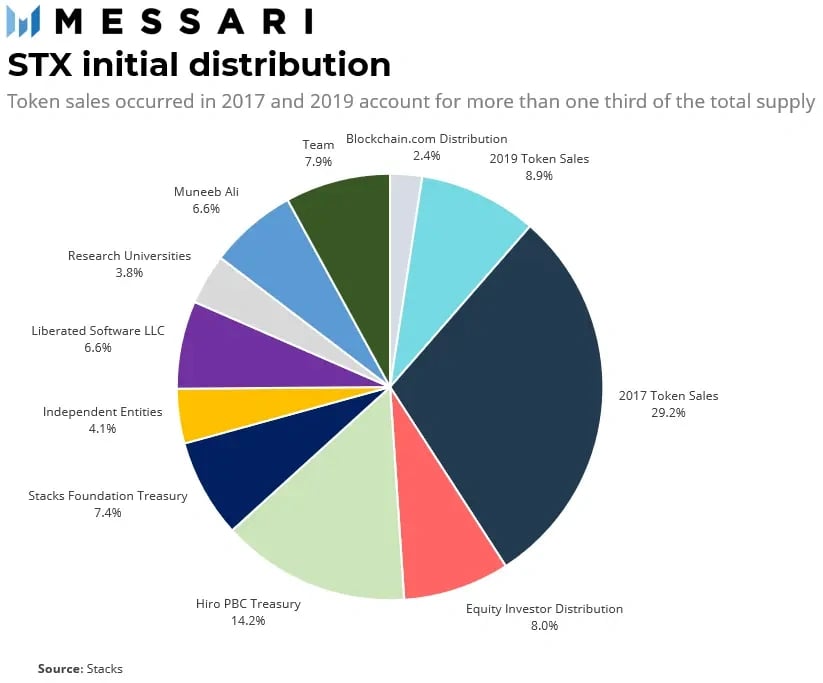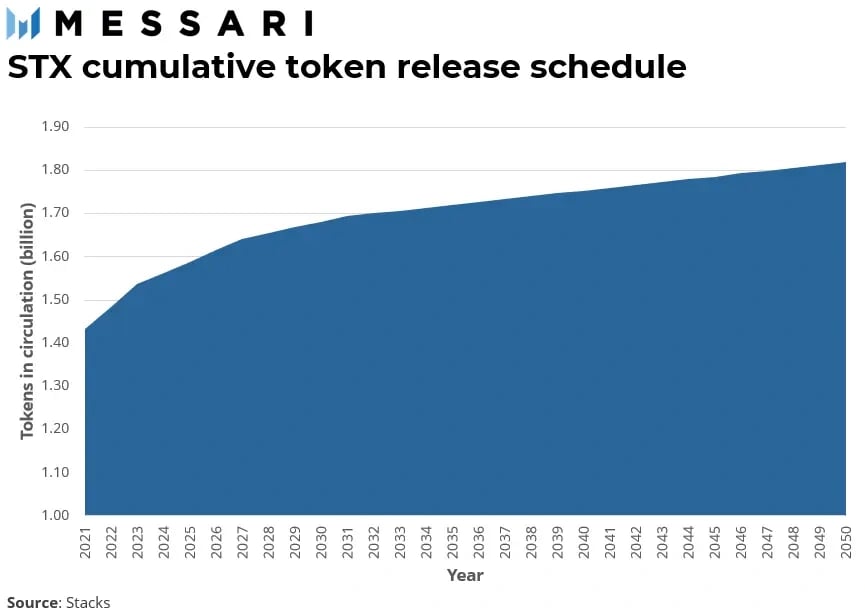위키 구독하기
Share wiki
Bookmark
STX (token)
STX (token)
STX 토큰은 스택스 플랫폼의 네이티브 토큰입니다. 스마트 계약 실행, 트랜잭션 처리, 비트코인 프로토콜 상의 새로운 디지털 자산 등록에 사용됩니다. [1]
개요
STX는 스택스(Stacks)의 공식 프로그래밍 언어인 Clarity로 작성된 스마트 계약을 실행하는 연료로 사용하도록 설계되었습니다. STX 보유자는 스태킹(Stacking)이라는 과정을 통해 토큰을 잠금으로써 합의에 참여하고 비트코인 보상을 받을 수 있습니다. 스태킹에 참여하려면 STX 보유자는 전체 노드를 실행하고 STX를 잠가야 하며, 수익률은 유동 공급량 중 참여 비율을 포함한 다양한 요소에 따라 달라집니다. 예를 들어, 유동 공급량의 50%가 참여하는 경우, 다른 매개변수가 일정하게 유지된다고 가정하면 수익률은 약 9%가 될 수 있습니다. [2]
또한, 스택스의 장기적인 가치는 Clarity 스마트 계약에 대한 수요와 스택스 네트워크의 성장과 관련이 있습니다. 네트워크에 Clarity 스마트 계약을 배포하려면 사용자는 연료 또는 가스 수수료로 STX를 지불해야 합니다. 사용자가 블록체인 네트워크의 블록에 트랜잭션을 포함시키기 위해 지불하는 수수료를 가스 수수료라고도 합니다. [2]
채굴
스택스 채굴자는 비트코인을 사용하여 STX 토큰을 채굴하며, 스택스 보유자는 STX를 잠금으로써 BTC를 얻을 수 있으므로 STX는 비트코인으로 가격이 책정되고 BTC 수익을 제공하는 암호화폐입니다. [2]
STX 채굴자는 리더 선출에 참여하기 위해 비트코인 블록체인에서 트랜잭션을 전송합니다. 그러면 검증 가능한 난수 함수(VRF)가 각 라운드의 리더를 무작위로 선택하며, 더 높은 BTC 입찰에 더 큰 가중치가 부여됩니다. 새로운 리더는 스택스 체인에 새로운 블록을 작성합니다. [2]
STX 채굴자는 트랜잭션 수수료 형태로 새로 생성된 STX를 받으며, Clarity 계약 실행 수수료도 STX로 지불됩니다. 채굴자는 채굴 비용을 BTC로 표시하고 리더 선출에 참여하기 위해 BTC를 사용합니다. 채굴자들이 선출을 위해 입찰한 BTC는 합의에 참여하는 STX 토큰 보유자에게 해당하는 특정 주소로 전송되므로, 채굴 과정에서 소비된 비트코인은 스택스 보유자의 STX 보유량을 기준으로 보상으로 사용될 수 있습니다. [2]
스태킹
스태킹은 스택스 블록체인 생태계 내에서 Proof of Transfer (PoX)라고 하는 합의 프로세스에 적극적으로 참여하는 STX 토큰 보유자에게 보상을 제공하는 메커니즘입니다. 스태커(Stackers)라고 불리는 스태킹 참여자는 새로운 블록이 채굴될 때마다 채굴자로부터 프로토콜이 보낸 BTC 보상을 받아 네트워크 가치에 대한 기여를 인정받습니다. 적격 스태커는 일반적으로 스태킹 주기(예: 7일, 변경될 수 있음)마다 한 번 정도 BTC 보상을 받습니다. 스택스 수익 모델은 스태킹 참여로 얻을 수 있는 잠재적인 BTC 보상을 추정하는 데 도움이 될 수 있습니다. 스택 보유자는 스택스 지갑 4.x 이상 버전과 다양한 기관에서 제공하는 기타 애플리케이션 및 서비스를 사용하여 스태킹에 참여할 수 있습니다. 스태킹에 직접 참여하려면 동적인 최소 STX 금액(대략 메인넷 기준 100,000k STX, 전체 참여 및 공급량에 따라 변동될 수 있음)이 필요합니다. 또는 이 최소 금액을 충족하지 못하는 스택스 보유자는 제3자 스태킹 위임 서비스를 이용하여 자신의 보유량을 다른 사람들과 합쳐서 공동으로 참여할 수 있습니다. [4]
토큰 경제
스택스 암호화폐는 제네시스 블록에 13억 2천만 STX가 있습니다. 배포는 2017년에 스택스가 약 4,700만 달러를 모금하고 투자자들이 STX를 0.12달러에 구매한 초기 코인 오퍼링을 통해 이루어졌습니다. 2019년에는 두 차례의 SEC 규제 코인 오퍼링이 있었습니다. Reg S 오퍼링은 STX 가격이 0.25달러인 상태에서 760만 달러를 모금했고, Reg A+ 오퍼링은 STX 가격이 0.3달러인 상태에서 1,550만 달러를 모금했습니다. [3]

2020년 10월, 스택스 경제 정책이 적응형 소각-및-발행 메커니즘에서 감소하는 발행 모델로 변경되었습니다. 이러한 변경은 2050년까지 약 18억 1,800만 개의 미래 공급량을 생성하는 것을 목표로 합니다.

잘못된 내용이 있나요?
